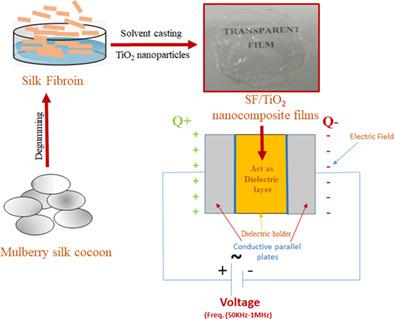当前位置:
X-MOL 学术
›
Polym. Int.
›
论文详情
Our official English website, www.x-mol.net, welcomes your
feedback! (Note: you will need to create a separate account there.)
N-type silk fibroin/TiO2 nanocomposite transparent films: electrical and optical properties
Polymer International ( IF 2.9 ) Pub Date : 2021-08-14 , DOI: 10.1002/pi.6285 Reetu Yadav 1 , Radhika Batra 1 , Priya Bansal 1 , Roli Purwar 1
Polymer International ( IF 2.9 ) Pub Date : 2021-08-14 , DOI: 10.1002/pi.6285 Reetu Yadav 1 , Radhika Batra 1 , Priya Bansal 1 , Roli Purwar 1
Affiliation

|
This paper highlights the effect of different concentrations of titanium dioxide (TiO2) nanoparticles on the electrical and optical properties of silk fibroin (SF). TiO2 based SF nanocomposite films were prepared using the solvent casting method. Uniform dispersion and agglomeration of nanoparticles, in nanocomposite films, were observed by field emission SEM. The conductivity of pure SF and nanocomposite films was determined by a four-point probe and the TiO2 nanoparticles were found to bring high conductivity to the nanocomposite films. Dielectric strength improved with the addition of nanoparticles to the SF matrix. Dielectric constant and capacitance of the pure SF and nanocomposite films were measured using an LCR meter, which showed a 10-fold enhancement on the addition of nanoparticles in SF. A very unusual property, i.e. negative resistance, was observed during LCR meter analysis for the nanocomposite films for a particular range of frequency (200–550 kHz), voltage (1 V) and current (0.5–1.5 μA). TiO2 nanoparticles changed the semiconducting behavior of the SF films from p-type to n-type as measured by the Hall effect experiment. The optical properties of pure SF and nanocomposite films were measured using a UV–visible spectrophotometer. The increased concentration of nanoparticles in the SF has effectively enhanced the absorbing coefficient, refractive index and percentage transmittance and reduced the bandgap energy. These SF/TiO2 nanocomposite films have shown the potential to be used as dielectric and high refractive index material for optoelectronics applications. © 2021 Society of Industrial Chemistry.
中文翻译:

N型丝素蛋白/TiO2纳米复合透明薄膜:电学和光学特性
本文重点介绍了不同浓度的二氧化钛 (TiO 2 ) 纳米粒子对丝素蛋白 (SF) 电学和光学性质的影响。使用溶剂浇铸法制备了基于TiO 2的SF纳米复合薄膜。通过场发射扫描电镜观察到纳米颗粒在纳米复合膜中的均匀分散和团聚。纯SF和纳米复合薄膜的电导率由四点探针和TiO 2发现纳米颗粒为纳米复合薄膜带来了高导电性。将纳米颗粒添加到 SF 基体后,介电强度得到提高。使用 LCR 计测量纯 SF 和纳米复合薄膜的介电常数和电容,结果表明,在 SF 中添加纳米颗粒后,性能提高了 10 倍。在对特定频率 (200–550 kHz)、电压 (1 V) 和电流 (0.5–1.5 μA) 范围内的纳米复合薄膜进行 LCR 计分析期间,观察到一个非常不寻常的特性,即负电阻。二氧化钛2通过霍尔效应实验测量,纳米颗粒将 SF 薄膜的半导体行为从 p 型改变为 n 型。使用紫外可见分光光度计测量纯 SF 和纳米复合薄膜的光学性能。SF中纳米颗粒浓度的增加有效地提高了吸收系数、折射率和透射率,并降低了带隙能量。这些SF/TiO 2纳米复合薄膜已显示出用作光电应用的介电和高折射率材料的潜力。© 2021 工业化学学会。
更新日期:2021-08-14
中文翻译:

N型丝素蛋白/TiO2纳米复合透明薄膜:电学和光学特性
本文重点介绍了不同浓度的二氧化钛 (TiO 2 ) 纳米粒子对丝素蛋白 (SF) 电学和光学性质的影响。使用溶剂浇铸法制备了基于TiO 2的SF纳米复合薄膜。通过场发射扫描电镜观察到纳米颗粒在纳米复合膜中的均匀分散和团聚。纯SF和纳米复合薄膜的电导率由四点探针和TiO 2发现纳米颗粒为纳米复合薄膜带来了高导电性。将纳米颗粒添加到 SF 基体后,介电强度得到提高。使用 LCR 计测量纯 SF 和纳米复合薄膜的介电常数和电容,结果表明,在 SF 中添加纳米颗粒后,性能提高了 10 倍。在对特定频率 (200–550 kHz)、电压 (1 V) 和电流 (0.5–1.5 μA) 范围内的纳米复合薄膜进行 LCR 计分析期间,观察到一个非常不寻常的特性,即负电阻。二氧化钛2通过霍尔效应实验测量,纳米颗粒将 SF 薄膜的半导体行为从 p 型改变为 n 型。使用紫外可见分光光度计测量纯 SF 和纳米复合薄膜的光学性能。SF中纳米颗粒浓度的增加有效地提高了吸收系数、折射率和透射率,并降低了带隙能量。这些SF/TiO 2纳米复合薄膜已显示出用作光电应用的介电和高折射率材料的潜力。© 2021 工业化学学会。











































 京公网安备 11010802027423号
京公网安备 11010802027423号